Vision 2000-C™ XD & Vision 2000-E™ XD High Sensitivity RGAs for Multi-pressure & CVD/ALD Processes
Overview
The Vision 2000-C™ XD and Vision 2000-E™ XD systems allow seamless monitoring of a wide range of semiconductor applications, including the complete ALD, CVD, and Etch processes, from base vacuum to process pressures up to 700 Torr. Both systems incorporate patented V-lens™ technology, taking the proven performance of the Vision 2000-C and Vision 2000-E systems to a new level of sensitivity and reliability, previously unachievable with conventional quadrupole mass spectrometry systems (QMS).
- In situ monitoring during chamber clean, passivation and deposition
- Up to 10 times increased sensitivity at lower masses (<15ppb)
- Reliable distinction between gases and background
- UniBloc™ fast-response inlet valve for sampling at background and process pressures
- Integration with a wide range of ALD, CVD, and Etch tools
Products
| Compare | Description | Drawings, CAD & Specs | Availability | Price | |||
|---|---|---|---|---|---|---|---|

|
CVD or Etch Process Monitor, High Sensitivity, 1-300 amu, Multi-pressure
|
VISION-2000-C-XD CVD or Etch Process Monitor, High Sensitivity, 1-300 amu, Multi-pressure |
|
||||

|
CVD or Etch Process Monitor, High Sensitivity, 1-200 amu, Multi-pressure
|
VISION-2000-E-XD CVD or Etch Process Monitor, High Sensitivity, 1-200 amu, Multi-pressure |
|
Specifications
-
Mass Range1-300 amu
-
Ion SourceHigh conductance closed ion source
-
FilamentsIndependently replaceable twin Tungsten filaments
-
Mass FilterDouble filter (1-inch "RF only" pre-filter with 4-inch main filter)
-
DetectorDual (Faraday and secondary electron multiplier)
-
Maximum Analyzer Operating Pressure1e-3 Torr at the ion source inlet (standard), higher pressure optional
-
Minimum Detectable Partial Pressure<2e-11 Torr (for total pressures <1e-4 Torr on baseline inlet)
-
Minimum Detectable Concentration<15ppb specified with Argon or Nitrogen
-
Mass StabilityBetter than ±0.1 amu over 8 hours
-
ResolutionBetter than 10% valley between peaks of equal height throughout the mass range
-
Base Pressure RangeIon source at maximum pressure at 1 mTorr, 10 mTorr or 100 mTorr
-
Process Pressure RangeIon source at maximum pressure at 10 mTorr, 100 mTorr, 500 mTorr, 1.5 Torr, 5 Torr, 10 Torr, 40 Torr, 100 Torr or 700 Torr
-
Mounting FlangeDN35CF (70mm/2.75 inches OD) Conflat® flange
-
Vacuum Hardware60 l/s turbomolecular pump with high conductance analyzer housing, inlet system, UniBloc™ inlet, automated vacuum control (RVC) completely interlocked and integrated
-
Backing Vacuum SystemStandard: Connected to the tool foreline pump via Surge Protect assembly with a KF16 fitting
Optional: Independent chemically resistant, dry diaphragm pump with KF16 fitting for connecting the exhaust to a suitable scrubber system -
Bakeout Temperature and Bakeout JacketIncluded for 180°C bakeout
-
Operating TemperatureElectronics: 10-40°C
-
WeightControl Module: 1.7 kg
-
Mechanical SupportOptional stands and brackets are available
-
Mobile RGA PlatformOptional RGA trolley to improve versatility (footprint 18x24 inches, 455x604mm)
-
Pneumatics60-80 psig CDA
-
Power Requirements88-264 VAC, 47/63 Hz, 600 Watts
-
Maximum Operating Conditions80% RH (non condensing)
-
LED Status IndicationInterlock status, filament emission, SEM, power and communications
-
I/O Capability4 analog inputs and 2 outputs (plus 1 dedicated gauge input). Optional support for a large number of both analog and digital inputs and outputs, including relay control
-
Other FacilitiesLeak check headset socket, external filament trip socket, instrument reset
-
SoftwareProcess Eye® Professional fully network compatible control platform generating under 32bit or 64bit Microsoft® Windows® xP, Vista, Server 2008 or Windows 7* (*recommended)
-
CommunicationEthernet CAT-5e
-
PC RequirementsIntel® Pentium IV® or AMD Athlon xP 1.2GHz, 1GB RAM, 120 GB hard drive, dependent upon total number of sensors on the computer and the operating system in use. Multi-sensor installation may require higher specifications.
-
Simultaneous Multi-SensorProcess Eye Professional client/server configuration offers flexible multi-sensor operation.
-
Shipping Weight44 lbs (20 Kg)
-
ComplianceCompliant to RoHS Directive 2002/95/EC (control unit)
Features
V-lens™ Technology
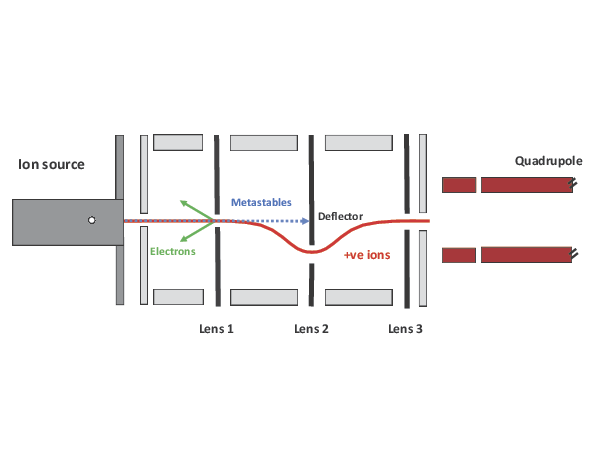
V-lens Ion Optics Technology - Trajectories of negative ions (green), positive ions (red), neutral ions (blue) in the V-lens ion optics, reducing metastable decay
Degas processes typically employ inert gases such as Argon or Nitrogen. The use of these gases can be challenging as they generate an elevated baseline in RGAs due to large amounts of chemical background noise caused by metastable decay. This results in reduced sensitivity which can be problematic for manufacturers who want to identify changes in trace gases (which are indicative of issues during the manufacturing process) quickly and easily.
V-lens technology, a unique enabling solution, helps to overcome this issue by providing a consistently low mass independent baseline and detection levels in the low ppb range. This is achieved with unique ion optics that utilize a patented double-focusing and deflection mechanism that significantly reduces background and enhances sensitivity (see figure).
The result is a gas analyzer with limits of detection in the low ppb range without compromise to any other aspect of instrument performance.
This state-of-the-art RGA technology is integrated with Process Eye Professional control platform, a recipe based, user-configurable software program. The combination of V-lens, a closed ion source, and automated inlet allows for sensitive and reproducible monitoring of the complete ALD, CVD, or Etch process cycle.
By maximizing the ratio between ALD, CVD, or Etch chamber gas signals and the gas background in the differentially pumped analyzer housing, the V-lens and closed ion source enables low ppm-level detection for trace contaminants in the process gas.
Closed Ion Source
The closed ion source analyzer is manufactured from vacuum prepared stainless steel and high density alumina ceramics, and features independently replaceable twin filaments to provide built-in backup in the event of a filament failure. The standard system includes a double filter analyzer for increased sensitivity of higher mass species, contamination resistance and enhanced long-term stability.
Remote Vacuum Controller
Each Vision 2000-C XD and Vision 2000-E XD system incorporates a Remote Vacuum Controller (RVC) module that provides fail-safe protection for both the process tool and the RGA. It allows full operation and control of RGA system components (filaments, pumps, inlet valves, bake-out, etc.) from the system PC.
UniBloc™ Inlet Valve
The fast-response UniBloc inlet valve allows sampling at both background and process pressure. When not sampling, both the valve and analyzer are automatically isolated from the process chamber and purged with inert gas. Purging is via the mass spectrometer pumping system, not through the process chamber. Purging is also used during bakeout, reducing initial startup time and residual background recovery time.
For sampling up to 10 Torr, a special 4-valve UniBloc is available for bypass pumping to facilitate the faster transfer of sample gas to the inlet, thereby optimizing inlet response time. Above 10 Torr, the 4-valve configuration is always used. The inlet valve is operated by integrated electronics and controlled via recipes from Process Eye Professional. The required valve selection is made automatically by a gas independent pressure sensor in the UniBloc inlet that also provides a read out of the process chamber total pressure. The internal seals are Kel-F® for compatibility with ALD, CVD, and Etch process gases. The external seals are all metal.
Process Eye™ Professional Control Platform
The Vision 2000-C XD and Vision 2000-E XD analyzers use Process Eye Professional. This highly flexible, modular application uses recipes to specify how the instrument scans, displays data, and responds to the acquired data. Recipes, user configurable using the “Recipe Wizard,” allow customized warnings and alarm levels, triggered whenever the process exceeds preset levels.
Other key parameters can also be set via the recipe. This allows optimization for each stage of the process. Process Eye Professional provides:
- Automated and intelligent operation of MKS RGAs
- Recipes for automated calibration
- Flexible scanning — “Bar Chart”, “Analog”, and “Peak Jump” modes can be associated with data trend displays
- Intelligent, user defined warnings and alarms include a suggested diagnosis of the fault condition and a recommendation for its solution
- Optional ability to read data from other sensors using analog inputs and external events by digital inputs
- Data buffer for quick on-line review of recent data
- Full storage of all data for review and analysis
TOOLweb® RGA
Using the TOOLweb RGA sensor integration option for process tools, the Vision 2000-C XD and Vision 2000-E XD can be used as a degas chamber sensor in a completely automated process environment (Figure 4). TOOLweb RGA maintains a constant monitoring of tool activities with all sensor data being framed by wafer logistics before alarm models are applied. Full alarm and data reporting to the FAB host and FDC are available allowing real-time monitoring of chamber conditions and flagging of any process excursions from ideal conditions.
Resources
Drawings & CADs
- Vision 2000-C™ XD & Vision 2000-E™ XD Dimensional Drawing (388.8 kB, PDF)
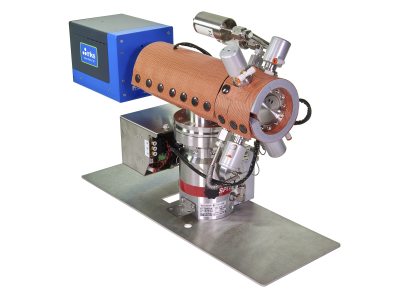
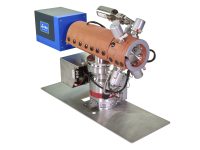
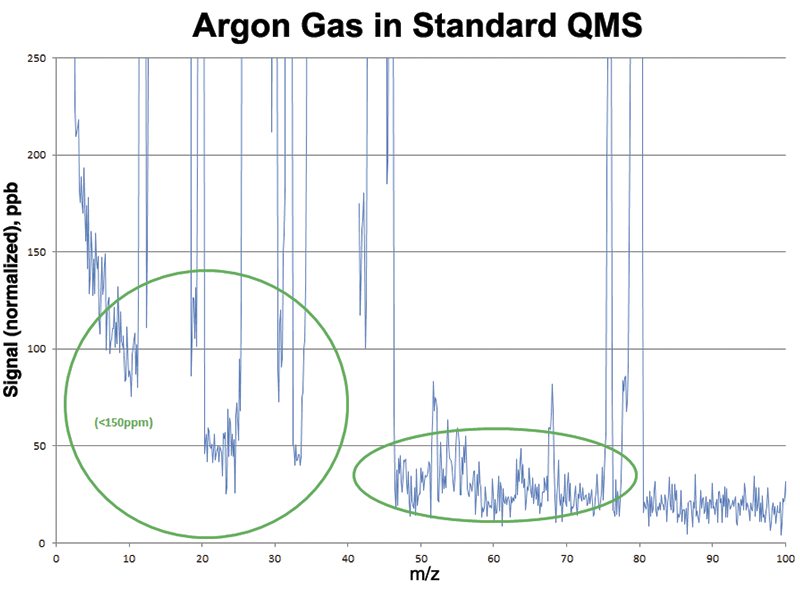
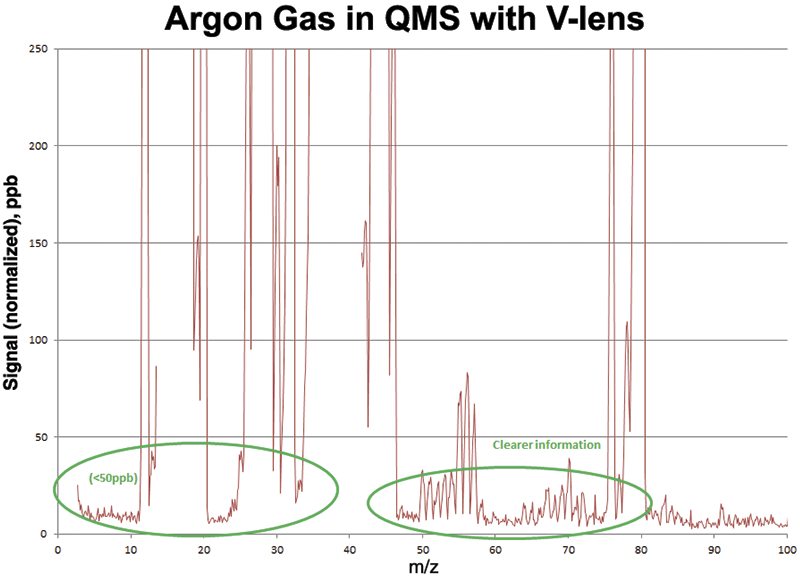
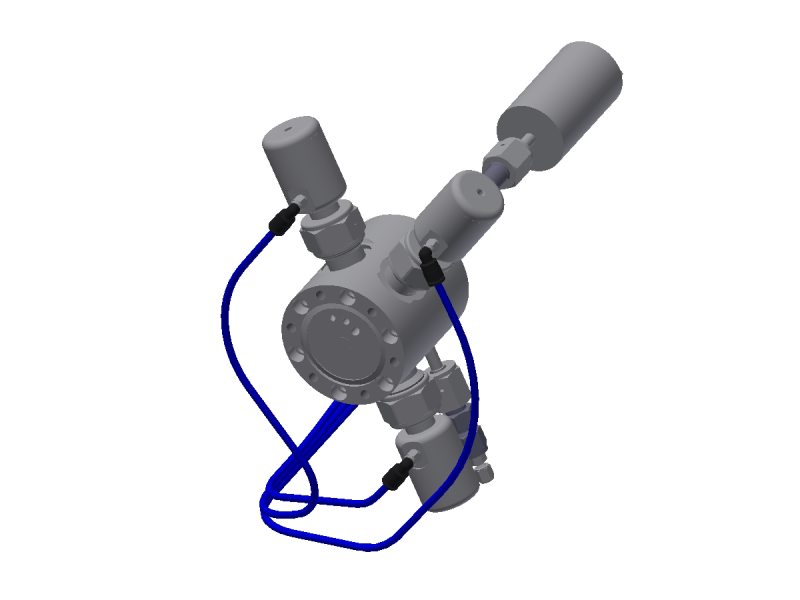
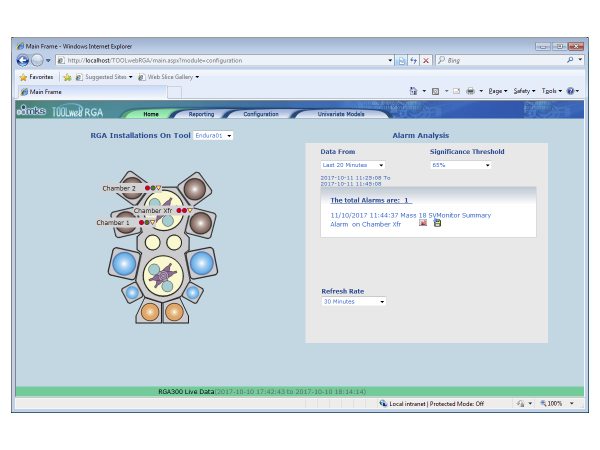



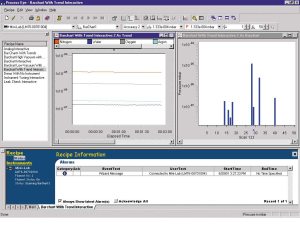
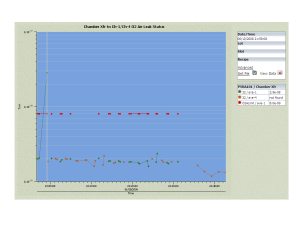
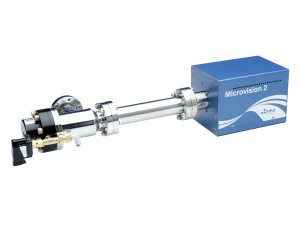
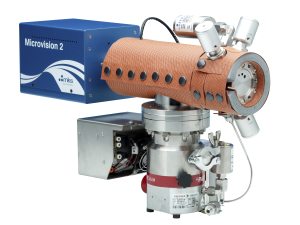
 Ultra-High Velocity
Ultra-High Velocity